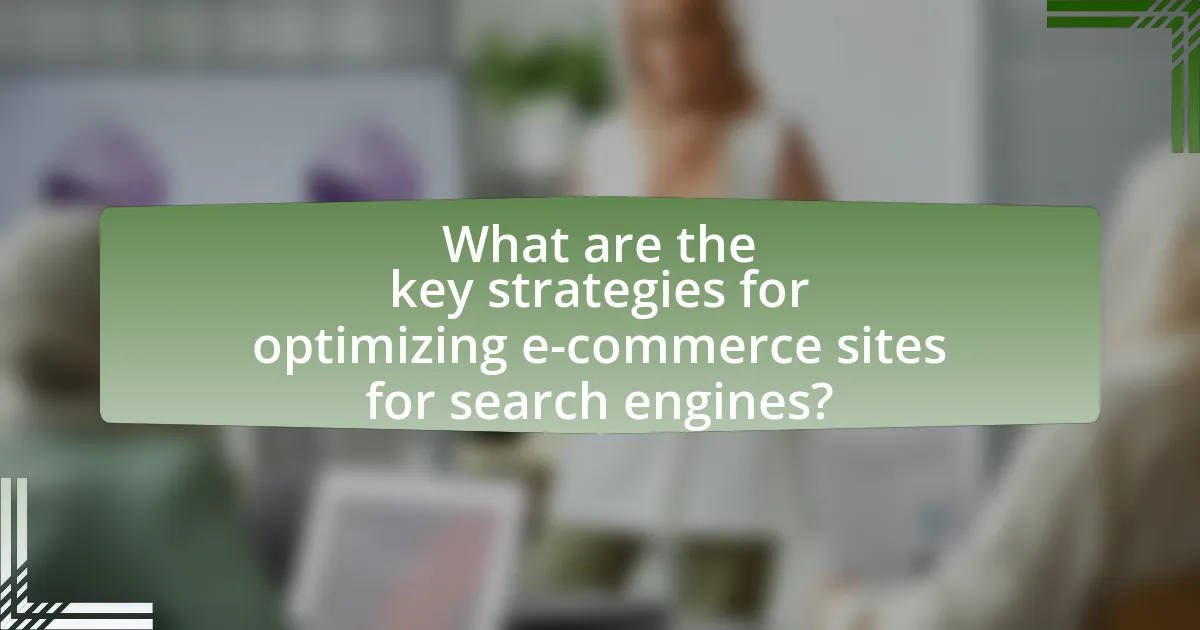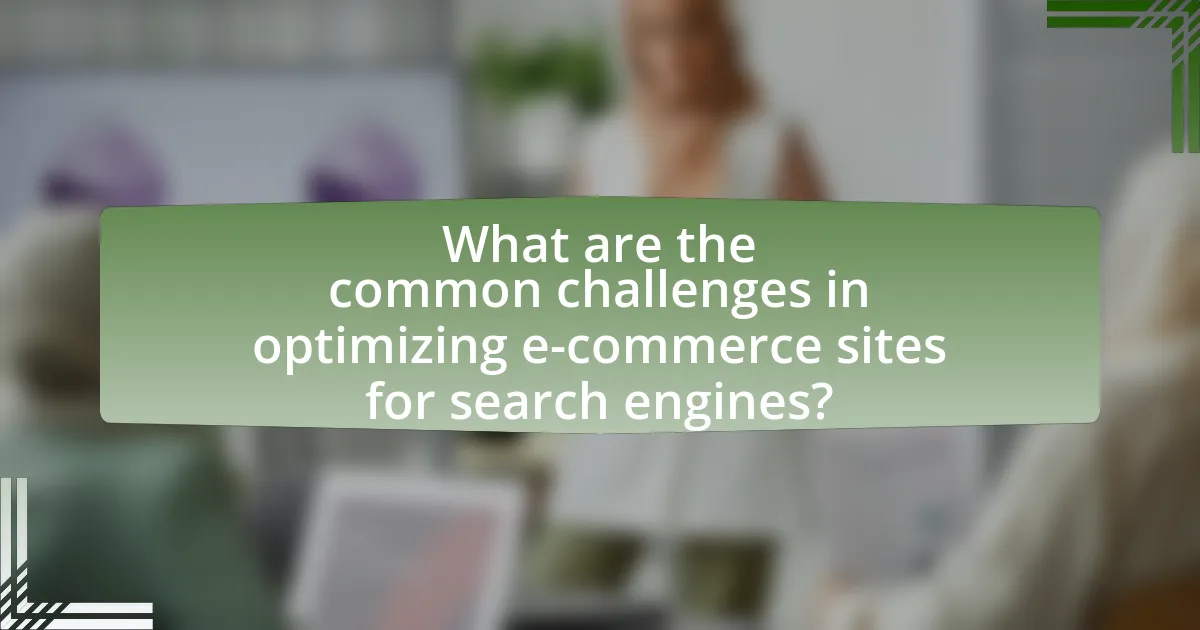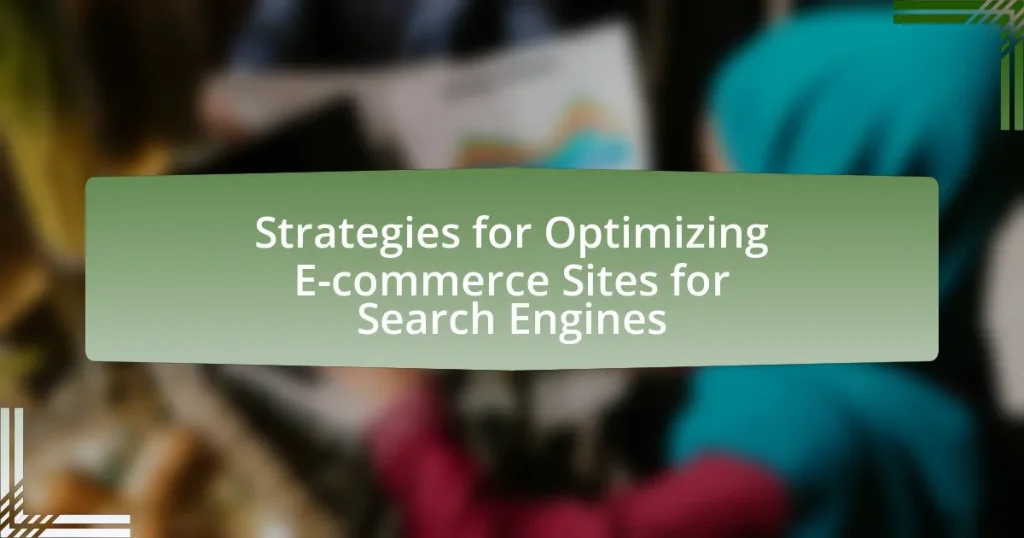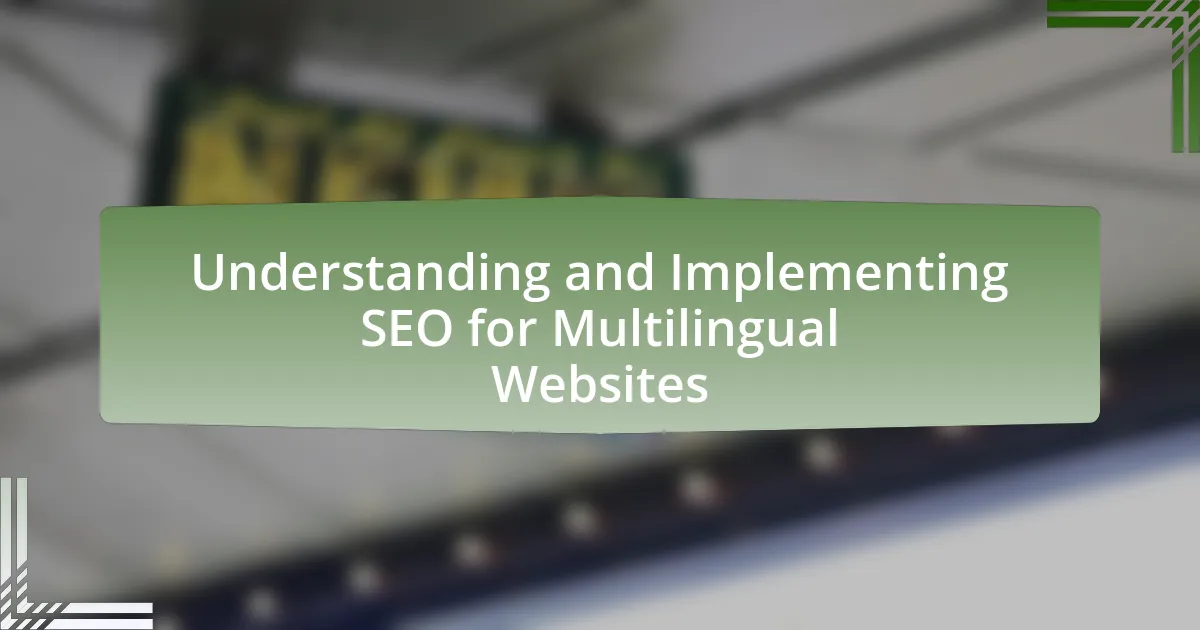The article focuses on strategies for optimizing e-commerce sites for search engines, emphasizing the importance of keyword research, product description optimization, site speed enhancement, structured data utilization, and mobile-friendliness. It details how on-page SEO techniques, such as keyword placement and meta tag optimization, can improve visibility and engagement. Additionally, the article explores off-page SEO strategies, including link building and social media marketing, as well as the significance of technical SEO in enhancing user experience and search rankings. Common challenges faced by e-commerce businesses in SEO implementation are also addressed, along with practical tips for immediate improvements and the role of emerging technologies in adapting to changing SEO trends.

What are the key strategies for optimizing e-commerce sites for search engines?
The key strategies for optimizing e-commerce sites for search engines include implementing keyword research, optimizing product descriptions, enhancing site speed, utilizing structured data, and ensuring mobile-friendliness. Keyword research helps identify relevant search terms that potential customers use, allowing for targeted content creation. Optimizing product descriptions with unique, informative content improves visibility and engagement, as search engines favor original material. Enhancing site speed is crucial, as studies show that a one-second delay can reduce conversions by 7%. Utilizing structured data, such as schema markup, helps search engines understand the content better, improving the chances of rich snippets in search results. Lastly, ensuring mobile-friendliness is essential, as over 50% of e-commerce traffic comes from mobile devices, and search engines prioritize mobile-optimized sites in rankings.
How do on-page SEO techniques enhance e-commerce site visibility?
On-page SEO techniques enhance e-commerce site visibility by optimizing individual web pages to rank higher in search engine results. These techniques include keyword optimization, where relevant keywords are strategically placed in titles, headings, and product descriptions, making it easier for search engines to understand the content. Additionally, improving site structure through proper internal linking and user-friendly navigation helps search engines crawl the site more effectively.
Furthermore, optimizing meta tags, such as title tags and meta descriptions, increases click-through rates by providing concise and appealing summaries of page content. According to a study by Moz, on-page factors contribute to approximately 25% of ranking factors in search engines, underscoring the importance of these techniques in driving organic traffic to e-commerce sites.
What role do keywords play in on-page optimization for e-commerce?
Keywords are essential in on-page optimization for e-commerce as they directly influence search engine rankings and user engagement. By strategically placing relevant keywords in product titles, descriptions, and meta tags, e-commerce sites can improve visibility in search results, attracting more organic traffic. Research indicates that 75% of users never scroll past the first page of search results, highlighting the importance of effective keyword usage to capture potential customers’ attention. Additionally, using long-tail keywords can enhance conversion rates, as they often reflect specific user intent, leading to higher sales.
How can product descriptions be optimized for search engines?
Product descriptions can be optimized for search engines by incorporating relevant keywords, ensuring unique content, and enhancing readability. Including targeted keywords that potential customers use in search queries helps improve visibility in search engine results. Unique content prevents duplication issues and enhances the likelihood of ranking higher. Additionally, using clear and concise language, bullet points, and headings improves readability, which can lead to better user engagement and lower bounce rates. According to a study by SEMrush, pages with optimized product descriptions can see a significant increase in organic traffic, demonstrating the effectiveness of these strategies.
What off-page SEO strategies are effective for e-commerce sites?
Effective off-page SEO strategies for e-commerce sites include building high-quality backlinks, engaging in social media marketing, and leveraging influencer partnerships. High-quality backlinks from reputable websites enhance domain authority and improve search rankings; for instance, a study by Moz indicates that backlinks are a significant ranking factor. Social media marketing increases brand visibility and drives traffic, with platforms like Instagram and Facebook being particularly effective for e-commerce. Influencer partnerships can amplify reach and credibility, as influencers often have dedicated followings that trust their recommendations, leading to increased conversions. These strategies collectively enhance the online presence and search engine performance of e-commerce sites.
How does link building impact e-commerce SEO?
Link building significantly enhances e-commerce SEO by improving a website’s authority and visibility in search engine results. When e-commerce sites acquire high-quality backlinks from reputable sources, search engines interpret this as a signal of trustworthiness and relevance, which can lead to higher rankings. For instance, a study by Moz indicates that backlinks are one of the top three ranking factors for Google, underscoring their importance in SEO strategy. Additionally, effective link building can drive referral traffic, further increasing the potential for conversions and sales on e-commerce platforms.
What are the benefits of social media for e-commerce SEO?
Social media significantly enhances e-commerce SEO by driving traffic, increasing brand visibility, and improving search engine rankings. When e-commerce businesses actively engage on social media platforms, they can attract more visitors to their websites, which signals to search engines that the site is relevant and popular. According to a study by HubSpot, 54% of social media users browse products on social media, leading to increased website visits. Additionally, social media profiles often rank in search engine results, providing more opportunities for brand exposure. Furthermore, social media facilitates content sharing, which can generate backlinks to the e-commerce site, further boosting its SEO performance.
Why is technical SEO crucial for e-commerce websites?
Technical SEO is crucial for e-commerce websites because it enhances site visibility and improves user experience, directly impacting conversion rates. E-commerce platforms often have complex structures with numerous product pages, making it essential for search engines to crawl and index these pages effectively. For instance, a study by Moz indicates that 70% of online experiences begin with a search engine, highlighting the importance of being easily discoverable. Additionally, technical SEO practices such as optimizing site speed, ensuring mobile-friendliness, and implementing structured data can lead to higher rankings in search results, which is vital for driving traffic and sales.
What technical elements should be optimized for better search rankings?
To achieve better search rankings, technical elements such as website speed, mobile-friendliness, secure connections (HTTPS), structured data, and XML sitemaps should be optimized. Website speed is crucial, as Google has indicated that faster-loading pages lead to better user experience and higher rankings. Mobile-friendliness is essential due to the increasing number of users accessing sites via mobile devices; Google prioritizes mobile-optimized sites in its rankings. Secure connections (HTTPS) are favored by search engines, as they enhance user trust and data security. Implementing structured data helps search engines understand the content better, which can improve visibility in search results. Lastly, maintaining an updated XML sitemap ensures that search engines can efficiently crawl and index the site, further enhancing search rankings.
How does site speed affect e-commerce SEO performance?
Site speed significantly impacts e-commerce SEO performance by influencing user experience and search engine rankings. Faster-loading websites lead to lower bounce rates, as users are less likely to abandon a site that loads quickly. According to Google, a one-second delay in page load time can result in a 20% decrease in conversions. Additionally, search engines like Google consider site speed as a ranking factor; websites that load faster are more likely to rank higher in search results. This correlation between speed and SEO performance is supported by research from Akamai, which found that 47% of consumers expect a web page to load in two seconds or less. Therefore, optimizing site speed is crucial for enhancing both user engagement and search visibility in e-commerce.

What are the common challenges in optimizing e-commerce sites for search engines?
Common challenges in optimizing e-commerce sites for search engines include managing large product catalogs, ensuring proper site structure, and addressing duplicate content issues. E-commerce sites often feature thousands of products, making it difficult to implement effective SEO strategies consistently across all pages. A well-organized site structure is crucial for both user experience and search engine crawling, yet many e-commerce platforms struggle with this due to complex navigation and deep hierarchies. Additionally, duplicate content arises from product variations, such as size or color, which can dilute search rankings and confuse search engines. These challenges necessitate targeted strategies to enhance visibility and performance in search results.
What obstacles do e-commerce businesses face in SEO implementation?
E-commerce businesses face several obstacles in SEO implementation, including intense competition, technical challenges, and resource limitations. The intense competition arises from numerous online retailers vying for the same keywords, making it difficult for individual businesses to rank highly in search results. Technical challenges include issues like website speed, mobile optimization, and proper indexing, which can hinder search engine visibility. Additionally, many e-commerce businesses struggle with limited resources, such as budget constraints and insufficient expertise in SEO, which can impede their ability to effectively implement and maintain SEO strategies. These factors collectively contribute to the difficulties e-commerce businesses encounter in optimizing their sites for search engines.
How can duplicate content issues be resolved in e-commerce?
Duplicate content issues in e-commerce can be resolved by implementing canonical tags, which signal to search engines the preferred version of a webpage. This method helps consolidate link equity and ensures that search engines index the correct page, reducing the risk of penalties for duplicate content. Additionally, using unique product descriptions and optimizing URL structures can further mitigate duplication. According to a study by Moz, 70% of e-commerce sites experience duplicate content issues, highlighting the importance of these strategies for maintaining search engine visibility.
What are the implications of poor mobile optimization for e-commerce SEO?
Poor mobile optimization significantly harms e-commerce SEO by negatively impacting user experience and search engine rankings. When e-commerce sites are not optimized for mobile devices, they often lead to slow loading times, difficult navigation, and unresponsive design, which can result in high bounce rates. According to Google, 53% of mobile users abandon sites that take longer than three seconds to load. Additionally, search engines like Google prioritize mobile-friendly sites in their rankings, meaning that poor mobile optimization can lead to lower visibility in search results. This ultimately reduces organic traffic and potential sales for e-commerce businesses.
How can e-commerce sites adapt to changing SEO trends?
E-commerce sites can adapt to changing SEO trends by implementing a mobile-first design, optimizing for voice search, and focusing on user experience. Mobile-first design is crucial as over 50% of global web traffic comes from mobile devices, necessitating responsive layouts and fast loading times. Optimizing for voice search is essential since 27% of the global online population uses voice search on mobile, requiring e-commerce sites to incorporate natural language and question-based keywords. Additionally, enhancing user experience through intuitive navigation, high-quality images, and fast checkout processes can lead to lower bounce rates and higher conversion rates, as studies show that a seamless user experience significantly impacts customer retention and sales.
What emerging technologies should e-commerce sites consider for SEO?
E-commerce sites should consider artificial intelligence (AI), voice search optimization, and augmented reality (AR) as emerging technologies for SEO. AI can enhance user experience through personalized recommendations and chatbots, which can lead to increased engagement and lower bounce rates, positively impacting search rankings. Voice search optimization is crucial as more consumers use voice-activated devices; optimizing for natural language queries can improve visibility in search results. AR can provide immersive shopping experiences, which can increase time spent on site and reduce return rates, further benefiting SEO performance. These technologies are increasingly shaping consumer behavior and search engine algorithms, making their integration essential for e-commerce SEO strategies.
How can voice search optimization be integrated into e-commerce strategies?
Voice search optimization can be integrated into e-commerce strategies by focusing on natural language processing and long-tail keywords that reflect conversational queries. E-commerce businesses should analyze common voice search phrases used by their target audience, ensuring product descriptions and content align with these queries. According to a 2021 report by ComScore, 50% of all searches are expected to be voice searches, highlighting the necessity for e-commerce sites to adapt. Additionally, optimizing for local SEO is crucial, as many voice searches are location-based; thus, including location-specific keywords can enhance visibility. Implementing structured data markup can also improve how search engines understand and display product information in voice search results.

What best practices should e-commerce sites follow for effective SEO?
E-commerce sites should implement several best practices for effective SEO, including optimizing product pages, improving site speed, and utilizing structured data. Optimizing product pages involves using unique, keyword-rich titles and descriptions, which can enhance visibility in search results. Improving site speed is crucial, as Google reports that 53% of mobile users abandon sites that take longer than three seconds to load. Utilizing structured data helps search engines understand the content better, potentially leading to rich snippets in search results, which can increase click-through rates. These practices collectively enhance user experience and search engine rankings, driving more organic traffic to e-commerce sites.
How can e-commerce sites create a user-friendly experience that supports SEO?
E-commerce sites can create a user-friendly experience that supports SEO by ensuring fast loading times, mobile optimization, and intuitive navigation. Fast loading times enhance user satisfaction and reduce bounce rates, which positively impacts search engine rankings; for instance, Google states that a one-second delay in loading time can lead to a 20% decrease in conversions. Mobile optimization is crucial as over 50% of global web traffic comes from mobile devices, and search engines prioritize mobile-friendly sites in their rankings. Intuitive navigation allows users to find products easily, improving user engagement and time spent on the site, which are factors that search engines consider when ranking pages.
What design elements contribute to both user experience and SEO?
Design elements that contribute to both user experience and SEO include responsive design, fast loading times, intuitive navigation, and clear calls to action. Responsive design ensures that websites function well on various devices, improving user engagement and reducing bounce rates, which positively impacts SEO rankings. Fast loading times enhance user satisfaction and are a ranking factor for search engines; studies show that a one-second delay can reduce conversions by 7%. Intuitive navigation helps users find information quickly, leading to longer site visits and lower exit rates, both of which are favorable for SEO. Clear calls to action guide users toward desired actions, improving conversion rates and user satisfaction, which can also influence search engine rankings.
How can customer reviews enhance SEO for e-commerce sites?
Customer reviews enhance SEO for e-commerce sites by generating unique, user-generated content that improves search engine visibility. When customers leave reviews, they often include relevant keywords and phrases related to the products, which can help search engines understand the context and relevance of the pages. According to a study by BrightLocal, 79% of consumers trust online reviews as much as personal recommendations, indicating that positive reviews can increase click-through rates and drive more organic traffic. Additionally, search engines prioritize fresh content, and regularly updated reviews can signal to search engines that the site is active and engaging, further boosting its ranking potential.
What tools and resources are available for e-commerce SEO optimization?
Various tools and resources are available for e-commerce SEO optimization, including keyword research tools, on-page optimization tools, and analytics platforms. Tools like Google Keyword Planner and SEMrush assist in identifying relevant keywords that drive traffic. On-page optimization tools such as Yoast SEO and Moz help improve website structure and content quality. Additionally, analytics platforms like Google Analytics and Ahrefs provide insights into user behavior and site performance, enabling data-driven decisions. These tools collectively enhance visibility and ranking in search engine results, which is crucial for e-commerce success.
Which analytics tools are essential for tracking e-commerce SEO performance?
Google Analytics, SEMrush, Ahrefs, and Moz are essential analytics tools for tracking e-commerce SEO performance. Google Analytics provides insights into website traffic, user behavior, and conversion rates, allowing e-commerce businesses to measure the effectiveness of their SEO strategies. SEMrush offers keyword tracking, site audits, and competitive analysis, which help identify opportunities for improvement. Ahrefs specializes in backlink analysis and keyword research, providing data on how well e-commerce sites rank for specific terms. Moz includes features like page optimization suggestions and rank tracking, which are crucial for maintaining and improving search visibility. These tools collectively enable e-commerce businesses to monitor their SEO performance effectively and make data-driven decisions.
How can e-commerce businesses leverage SEO plugins for better optimization?
E-commerce businesses can leverage SEO plugins to enhance their website optimization by utilizing features such as keyword analysis, meta tag management, and structured data implementation. These plugins provide tools that help identify relevant keywords, allowing businesses to optimize product descriptions and content effectively, which can lead to improved search engine rankings. For instance, plugins like Yoast SEO and Rank Math offer real-time feedback on SEO performance, enabling businesses to make data-driven adjustments. Additionally, structured data markup facilitated by these plugins can enhance search visibility through rich snippets, which can increase click-through rates. According to a study by Moz, websites that implement structured data can see a significant boost in organic traffic, validating the effectiveness of using SEO plugins for optimization.
What practical tips can e-commerce sites implement for immediate SEO improvements?
E-commerce sites can implement several practical tips for immediate SEO improvements, including optimizing product titles and descriptions with relevant keywords. This practice enhances visibility in search engine results, as keyword-rich content aligns with user search queries. Additionally, improving site speed is crucial; according to Google, a one-second delay in loading time can lead to a 20% drop in conversions. Implementing structured data markup helps search engines understand product information better, which can enhance rich snippets in search results. Lastly, ensuring mobile-friendliness is vital, as over 50% of global web traffic comes from mobile devices, and Google prioritizes mobile-optimized sites in its rankings.




